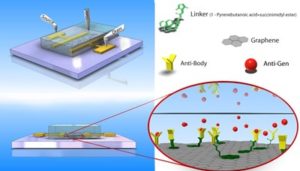Area 3 – Bioelectrochemistry and Biosensors
In the rapidly growing field of bioelectrochemistry and biosensors, CEST’s research focuses on the development of artificial electrochemical, biomimetic sensor platforms for the analysis of diverse biomedical and environmental target molecules. The development and optimisation of our biosensors enables e.g. better detection limits for difficult to detect “small” molecules, the specific analysis of problematic environmental samples, or the passivation of surfaces to improve the long-term stability of various sensors.
In the broad field of sensors, our core competencies lie in the production of graphene and functionalized graphene derivatives, their characterisation and implementation in sensor surfaces. Based on this, we immobilise various biomolecules as detector systems on the sensor surface and evaluate the entire system under real conditions. An alternative approach is the use of surface plasmon resonances, which allow the reading of the result via an optoelectrochemical way.
Based on a number of current projects in this research area, fundamental correlations have already been researched and methods have been established to open the way to new sensor types and concepts. The results of this research should ultimately enable our industrial partners to develop tailor-made solutions for their needs and thus identify toxic or environmentally hazardous substances at an early stage and make their processes and products safer.
Through the combination of our know-how from basic research and years of experience in practice, we are in a position to offer a range of solutions and also integrate the appropriate project partners necessary for a rapid and effective implementation of the desired project objectives.
Fast and cost-efficient concepts that detect contaminants on site without requiring an entire laboratory are desirable for a number of industrial problems. Based on these needs, depending on the problem, a targeted optimization or new development of appropriate measurement techniques and concepts is carried out. Concrete examples are, for example, the detection of pollutants in water, the detection of clinically relevant (tumor) markers, and the determination of toxins in food. All existing measuring systems can be adapted and optimised depending on the application.



